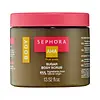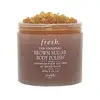What's inside
What's inside
 Key Ingredients
Key Ingredients

 Benefits
Benefits

 Concerns
Concerns

 Ingredients Side-by-side
Ingredients Side-by-side

Sucrose
HumectantHelianthus Annuus Seed Oil
EmollientWater
Skin ConditioningTrihydroxystearin
Skin ConditioningLactic Acid
BufferingSodium Hydroxide
BufferingPropanediol
SolventPolyglyceryl-3 Caprate
EmulsifyingParfum
MaskingPolyglyceryl-4 Oleate
EmulsifyingCaprylyl Glycol
EmollientCitric Acid
BufferingPolyglyceryl-3 Stearate
EmulsifyingPolyglyceryl-4 Diisostearate/Polyhydroxystearate/Sebacate
EmulsifyingSodium Benzoate
MaskingDiethylhexyl Syringylidenemalonate
Skin ProtectingLimonene
PerfumingCitral
PerfumingCaprylic/Capric Triglyceride
MaskingSucrose, Helianthus Annuus Seed Oil, Water, Trihydroxystearin, Lactic Acid, Sodium Hydroxide, Propanediol, Polyglyceryl-3 Caprate, Parfum, Polyglyceryl-4 Oleate, Caprylyl Glycol, Citric Acid, Polyglyceryl-3 Stearate, Polyglyceryl-4 Diisostearate/Polyhydroxystearate/Sebacate, Sodium Benzoate, Diethylhexyl Syringylidenemalonate, Limonene, Citral, Caprylic/Capric Triglyceride
Sucrose
HumectantPrunus Amygdalus Dulcis Oil
Skin ConditioningPrunus Armeniaca Kernel Oil
MaskingSimmondsia Chinensis Seed Oil
EmollientOenothera Biennis Oil
EmollientCitrus Limon Peel Oil
MaskingPassiflora Incarnata Seed Oil
Skin ProtectingCitrus Grandis Peel Oil
MaskingHelianthus Annuus Seed Oil
EmollientLitsea Cubeba Fruit Oil
MaskingCitrus Aurantium Bergamia Fruit Oil
MaskingCitrus Aurantium Dulcis Oil
MaskingCymbopogon Schoenanthus Oil
MaskingPanax Ginseng Root Extract
EmollientTocopherol
AntioxidantLimonene
PerfumingCitral
PerfumingLinalool
PerfumingBHT
AntioxidantTriethyl Citrate
MaskingSucrose, Prunus Amygdalus Dulcis Oil, Prunus Armeniaca Kernel Oil, Simmondsia Chinensis Seed Oil, Oenothera Biennis Oil, Citrus Limon Peel Oil, Passiflora Incarnata Seed Oil, Citrus Grandis Peel Oil, Helianthus Annuus Seed Oil, Litsea Cubeba Fruit Oil, Citrus Aurantium Bergamia Fruit Oil, Citrus Aurantium Dulcis Oil, Cymbopogon Schoenanthus Oil, Panax Ginseng Root Extract, Tocopherol, Limonene, Citral, Linalool, BHT, Triethyl Citrate
Alternatives
Ingredients Explained
These ingredients are found in both products.
Ingredients higher up in an ingredient list are typically present in a larger amount.
Citral is a fragrance and used to add a lemon-like scent to products. It is both naturally found in plants and created synthetically. In plants, it is commonly occurring in lemon myrtle, lemongrass, lemon tea-tree, lemon verbena, and other citruses.
The EU mandates Citral be listed separately as a fragrance. It is a known allergen and may cause contact dermatitis. Citral can also used as a masking ingredient.
The term 'fragrance' is not regulated in many countries. In many cases, it is up to the brand to define this term. For instance, many brands choose to label themselves as "fragrance-free" because they are not using synthetic fragrances. However, their products may still contain ingredients such as essential oils that are considered a fragrance.
The term 'citral' is a collective term for two geometric isomers: geranial/Citral A and neral/Citral B.
Learn more about CitralHelianthus Annuus Seed Oil is the oil derived from the seeds of a Sunflower. Sunflower seed oil is non-fragrant. It is an emollient, meaning it helps to soften the skin.
Sunflower seed oil contains many fatty acids. The fatty acids found in sunflower seeds include (from highest amount to least): linoleic acid, myristic acid, palmitic acid, stearic acid, arachidic acid, oleic acid, and linolenic acid.
These fatty acids help the skin create ceramides. Ceramides play a role in repairing the skin barrier.
Helianthus Annuus Seed Oil helps moisturize the skin. This in turn helps the skin look more rejuvenated and smoother.
Sunflowers are rich in vitamin E.
Historians believe Indigenous cultures of North America domesticated sunflowers before corn. Thus they relied on sunflower oil for a variety of uses. One such use is moisturizing skin and hair.
Sunflower seed oil may not be fungal acne safe. We recommend speaking with a professional if you have any concerns.
Learn more about Helianthus Annuus Seed OilLimonene is a fragrance that adds scent and taste to a formulation.
It's found in the peel oil of citrus fruits and other plants such as lavender and eucalyptus. The scent of limonene is generally described as "sweet citrus".
Limonene acts as an antioxidant, meaning it helps neutralize free radicals.
When exposed to air, oxidized limonene may sensitize the skin. Because of this, limonene is often avoided by people with sensitive skin.
The term 'fragrance' is not regulated in many countries. In many cases, it is up to the brand to define this term. For instance, many brands choose to label themselves as "fragrance-free" because they are not using synthetic fragrances. However, their products may still contain ingredients such as essential oils that are considered a fragrance.
Learn more about LimoneneSucrose is a natural sugar found in fruits, vegetables, and nuts. It is the main constituent of white sugar.
In skincare, sucrose is a humectant and can be a mild exfoliant.
Sucrose is hydrophilic, meaning it attracts water. This makes it an effective humectant and helps hydrate the skin.
Studies show sugars may worsen acne-prone skin due to it disrupting the skin's natural biome. We recommend speaking with a professional if you have any concerns.
In some products such as body scrubs, sucrose is used as an gentle exfoliant.
The term 'sucrose' comes from the french word for sugar, 'sucre'.
Learn more about Sucrose